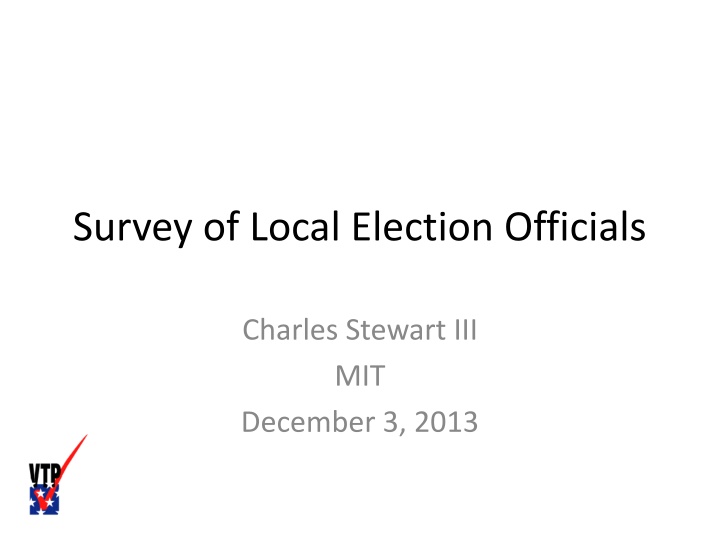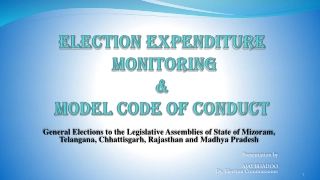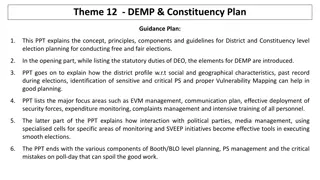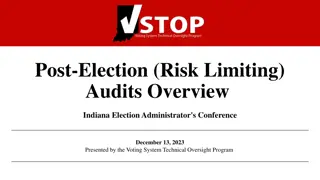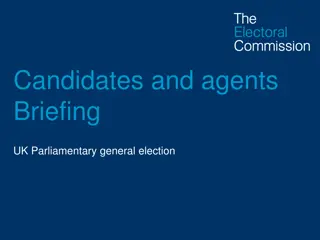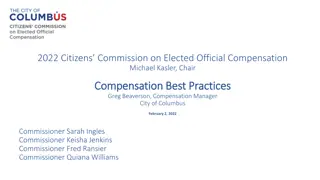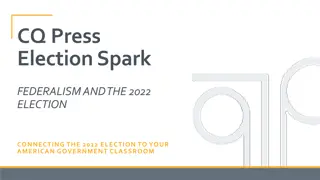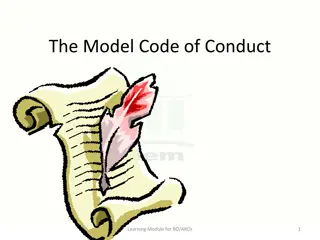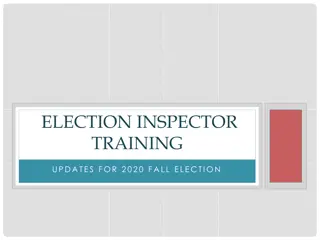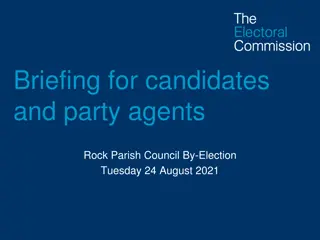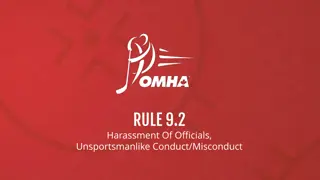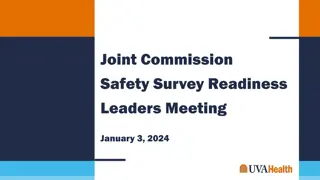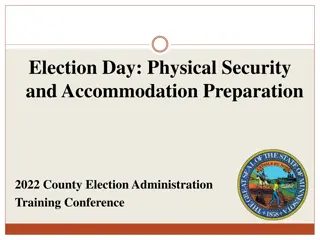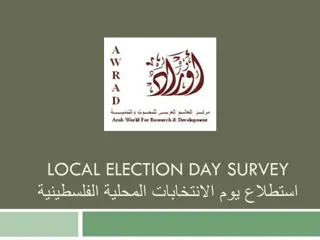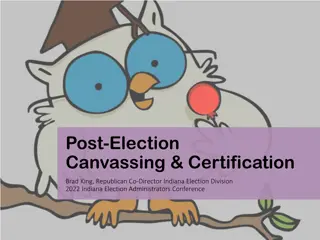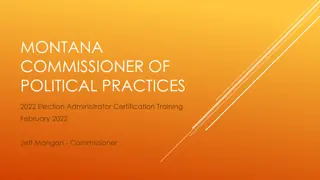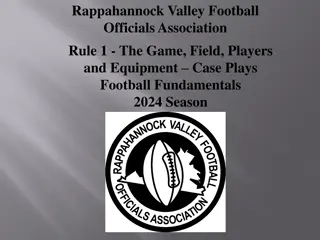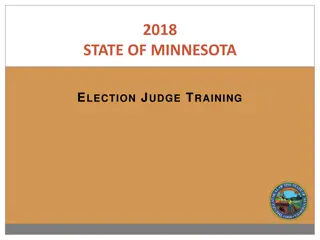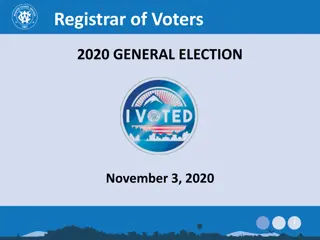Survey of Local Election Officials: Insights and Findings
Delve into the results of a comprehensive survey conducted amongst local election officials in the U.S. to gain valuable insights into election administration, challenges faced, and future improvements needed. Explore spending patterns, staffing statistics, and key topics discussed by the respondents.
Download Presentation

Please find below an Image/Link to download the presentation.
The content on the website is provided AS IS for your information and personal use only. It may not be sold, licensed, or shared on other websites without obtaining consent from the author.If you encounter any issues during the download, it is possible that the publisher has removed the file from their server.
You are allowed to download the files provided on this website for personal or commercial use, subject to the condition that they are used lawfully. All files are the property of their respective owners.
The content on the website is provided AS IS for your information and personal use only. It may not be sold, licensed, or shared on other websites without obtaining consent from the author.
E N D
Presentation Transcript
Survey of Local Election Officials Charles Stewart III MIT December 3, 2013
Background Purpose: To hear from the election administrators themselves, about what is happening, where we are headed, and what we need to do to improve elections.
Relationship to Cincinnati presentation Cincinnati: 1,400 responses Exploration of open-ended responses Today: 3,191 responses Exploration of close-ended responses
Survey Design Survey of all local election officials in the U.S. Conducted by Sentis Research, using a variety of modes Research team: Stephen Ansolabehere, Daron Shaw, and Charles Stewart III Data and reports will be made available through the Caltech/MIT Voting Technology Web site Research support provided by the William and Flora Hewlett Foundation and the Democracy Fund
Response rate 3,191/7,779 responses (41%) From every state except Wyoming Slight skew to Southern states Slight skew to medium-sized jurisdictions
Variety of contexts Nearly 8,000 local election jurisdictions in the United States Approximately 3,300 counties in the United States 50% of voters are in the 163 largest election jurisdictions (break at 241,213)
Topics Spending and staffing (Disaster planning) Organization of precincts Allocation of poll workers Training of poll workers Things that went well Things that were a challenge Lines Things that will be a challenge
Spending and Staffing Total spending in 2012 $2.6b Census of Government comparisons: 17/1000% of $1.5T local government spending 10% of general government spending A little larger than running parking facilities 26,300 central staff % of local government employees (Roughly 500,000 precinct staff) Equivalent to fire department or public hospital employment
Q6. Does your office have an explicit plan for running the election in the event of natural disasters or other emergencies that may disrupt elections? 1. Yes, we have an explicit plan 2. No, but we have a planning process under way 3. No, and we have no planning process currently under way 98. Don t know
No, but No, and not planning on one Size Yes planning on one Don t know Smaller 46.2% 21.1% 25.0% 7.7% Larger 66.7% 31.1% 2.2% 0.0% All 46.6% 21.3% 24.6% 7.6%
Organization of precincts How are poll workers allocated? How are voting machines allocated?
How Are Poll Workers Allocated? State Constraints Q18. Does your state have any rules regarding the number of poll workers that must be allocated to each polling place or is that left entirely up to your office?
How Are Poll Workers Allocated? State Constraints 41% State rules determine the number of poll workers per precinct 41% My state imposes some rules on the number of poll workers, but the local office has discretion 13% The number of poll workers at each precinct is entirely up to the local offices 5%Don t know
How are poll workers allocated? Q19. How do you determine how many poll workers there will be in each polling place?
The allocation of poll workers 23% I allocate poll workers in proportion to the number of people who voted in each precinct in the last similar election. 19% I allocate poll workers in proportion to the number of registered voters 17% I allocate poll workers based on a formula that is determined by state law or regulation. 12% I allocate the same number of poll workers to each polling place. 6% I allocate poll workers based on problems at polling places such as long lines at the last election. 7% I allocate based on the amount of voting equipment assigned to the polling place to support the turnout 2% I allocate based on language needs at the polling place 12% Other (specify)
Allocation rules vary by size Larger Smaller Number of reg. voters 31% 21% Number of actual voters 23% 17% Same number 0% 14% Problems (like long lines) 12% 6% Formula dictated by state 14% 24% Number of machines 18% 9% Language needs 9% 2%
The Training of Poll Workers Q21. How much training did the typical first- time poll-worker receive prior to the November, 2012, election? [An estimate is fine.] Q22. How much training did the typical poll- workers with the most responsibility (for example, polling place supervisors) receive prior to the November, 2012, election? [An estimate is fine.]
Average Hours Training Smaller jurisdictions Larger jurisdictions Total First-time worker 2.5 3.6 2.5 Chief worker 3.4 4.3 3.4
Q9. thinking about the 2012 elections, which of the following aspects of election administration worked especially well in your jurisdiction? (Choose up to 3)
Voting Technology and voting machine capacity Availability of Polling Places Management, Operation, and Design of Polling Places Availability of Poll Workers Training and Management of Poll workers Ballot Simplicity and Ballot design Voter education Management and processing of provisional ballots Management and processing of Absentee Voting Management and processing of Early Voting Accessibility for Uniformed and Overseas Voters Accessibility for people with disabilities or other special needs Ballot design, signage, and communications for people who do not speak English or with limited English proficiency Quality of Voter Registration Lists and Management of Poll Books Staffing of the Election Office on Election Night Keeping Lines to a Minimum Preparedness for natural disasters or other emergencies Other (specify) Nothing in particular/Don t know
Things that Went Well Smaller jurisdictions Larger jurisdictions All 1. Voting tech/machines 31.0% 30.9% 35.4% 2. Management/processing of absentee ballots 22.8% 22.9% 20.0% 3. Training/management of poll workers 21.8% 21.8% 24.6% 4. Availability of polling places 19.0% 19.2% 9.2% 5. Management/operation, design of polling places 17.7% 17.8% 10.8% 6. Quality of voter registration lists/poll books 15.5% 15.4% 20.0% 10. Management/processing of early voting 9.2% 8.9% 21.5%
Concerns Q10. What were the biggest concerns or problems in 2012?
Concerns Smaller jurisdictions Larger jurisdictions All 1. Nothing in particular 22.9% 23.2% 6.2% 2. Availability of poll workers 18.0% 18.0% 20.0% 3. Voter education 12.6% 12.6% 12.3% 4. Lack of funding/resources 10.6% 10.7% 7.7% 5. Postal Service issues 9.0% 8.9% 13.8% 9. Keeping lines to a minimum 12. Management/processing of provisional ballots 5.6% 5.5% 12.3% 4.2% 4.0% 13.8%
Did Someone Say Lines? Q26. Did your jurisdiction experience long lines (approximately one hour or more) at any precincts or early voting sites in the 2012 general election? 1. Yes, long lines were common and widespread 2. Yes, but only at some locations 3. Yes, but only at one or two locations 4. There were no appreciable lines in my jurisdiction 98. Don t know
Long lines common Long lines @ some Long lines @ 1 or 2 No long lines Size Don t know Smaller 1.9% 3.5% 7.3% 84.2% 3.1% Larger 2.7% 40.5% 27.0% 27.0% 2.7% All 1.9% 4.1% 7.6% 83.3% 3.1% All (weighted by eligible voters) 1.9% 26.2% 21.3% 48.0% 2.6%
What Caused the Lines? Q27. Which factors do you believe contributed most to those lines? [Please check all that apply]
1. Registration problems 2. Insufficient numbers of poll books 3. Inadequate space at the polling place 4. Insufficient numbers of voting machines or ballots 5. Insufficient numbers of poll workers at the location 6. Overly long or complicated ballots 7. Limited English proficiency of many voters 8. Inadequate education of Voters on How to Vote 9. People in the Wrong Precincts 10. Too many people showed up at the same time 11. Not enough early voting days/Increase in voters in last few days of early voting Other (specify) _______________________________ 98. Don t know
Smaller jurisdictions Larger jurisdictions All 1. Too many people showed up at the same time 56.6% 56.9% 53.8% 2. Overly long/complicated ballots 35.8% 34.4% 50.0% 3. People in wrong precinct 21.2% 22.1% 11.5% 4. Inadequate space @ polling place 16.9% 16.7% 19.2% 5. Registration problems 13.9% 14.5% 7.7% 7. Insufficient # of poll books 7.6% 6.9% 15.4% 9. Not enough early voting days 7.3% 6.5% 15.4%
Q16. Looking forward, over the next 5 to 10 years what areas of election administration are in significant need of improvement or an upgrade? (Choose 3)
Smaller jurisdictions Larger jurisdictions All 1. Voting tech. & voting machine capacity 24.3% 24.1% 36.9% 2. Availability of poll workers 21.9% 22.2% 9.2% 3. Voter education 17.9% 18.1% 7.7% 4. Training/management of poll workers 11.4% 11.4% 12.3% 5. Postal service issues 10.2% 10.2% 12.3% 10. Availability of polling places 6.5% 6.4% 15.4%
